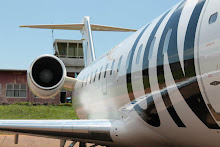December To Remember
It's been a while since I've had the time to post. Last time I checked in, it was just before the beginning of the last IOE trip. Due to having several legs canceled, it was necessary to have one more trip to meet the required IOE hourly minimums.
The last trip was a piece of cake. The check airman told me after the last leg of the first day that he would be signing me off. That made the trip go by quite a bit faster. The remainder of the trip was enjoyable and easy, except for a minor emergency that we handled on the last leg of the final day.
After IOE, I enjoyed 5 days off with my family before heading to New York to hunt for a crash pad and begin my reserve tenure at JFK. I found a crash pad in Queens near Jamaica Station that was willing to give me a flat rate for 7 weeks. It's a depressing little place with 8 beds in one room, a bathroom, a kitchen with no stove, a 13-inch tv with basic cable and inconsistent wireless internet. It is cheap and cheap is good right now.
Being on line is MUCH more relaxing than IOE. It's nice not being next to a line check airman having every move evaluated. I'm actually making fewer mistakes with the relaxation of being in a non-jeopardy position. It's also more fun.
The story that was being passed around prior to IOE was that new hire pilots are utilized heavily for the first 100 hours. Once a new pilot reaches 100 hours in the aircraft, several limitations are removed. I have been flying a lot and have already reached 100 hours which makes me eligible to take off and land at special use airports, on icy and contaminated runways, with crosswinds up to the aircrafts limitations, where wind shear is forecast and more. The first thing I'm looking forward to doing is The River Visual at Washington Reagan National. Hopefully it will pop up on my schedule soon.
The thing I've enjoyed most is visual approaches. With a greater comfort level in the aircraft, setting up and configuring for a visual approach is now routine. Very little time is spent in training teaching visuals and most of it is learned in the aircraft. Luckily, they haven't been a struggle for me. Things happen a lot faster on a visual approach and it isn't as regimented as a precision or non-precision approach. Most of the set up is at the pilot flying's discretion. Needless to say, being at 10,000 feet in the downwind and cleared for the visual approach can be a challenge. The CRJ is slippery and although there are several ways to slow it down, it has to be done quickly to ensure staying below 250 knots and configuring for a stabilized approach. I love doing visual approaches.
I have enjoyed several trips up and down the East Coast and have a few photos to share. I keep thinking about bringing the DSLR on a trip, but its bulk is too much. My Canon pocket camera doesn't do too well in low light situations, so a few of the photos are kind of noisy. Unfortunately, my internet connection here at the crash pad is unreliable and slow. For now, here is one photo.
This has been a busy week with several fill-in trips from Boston to Bangor. Big Sky Airlines has ceased East Coast operations and we are picking up several of their routes. Tomorrow, I start a 3 day trip with a round trip to Melbourne, FL and an overnight at LaGuardia. I am glad to have that versus being released at JFK to the crummy, depressing crash pad. The rest of the trip will keep me busy and put me close to 96 hours for December, just 4 hours shy of the legal limit. Right now, I'll take all of the flying I can get.
I'll try and post more photos, as well as a few interesting stories, when I have a better internet connection.
Flying good. Away from family, BAD. It really sucks to be 2,000 miles away on Christmas. I will be reassigned from JFK to CVG in February and hope that makes the commute easier...for the time being.




























